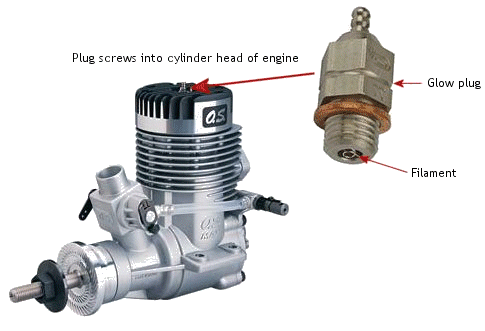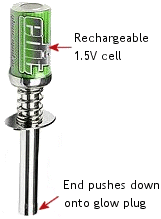Glow Plugs for RC Model Aircraft
Learning a bit about glow plugs for rc airplanes will help you make the right choice of plug for your engine, and that can make a big difference in its performance.
Of course, your engine instruction manual should make the correct recommendations for which glow plug(s) to use and these recommendations should be your first option for plug selection. The information outlined below should be taken as a general understanding of glow plugs only.
So what is a glow plug and why is it needed?
A glow engine (also often called 'nitro' or - sometimes generically - 'gas' engine) for an rc model plane, helicopter, car or boat runs on a special blend of fuel that contains methanol, oil and likely nitromethane.
While the oil is present to provide the necessary lubrication inside the engine, it is mainly the methanol and to a lesser extent the nitromethane that provide the combustible mixture that keeps your glow engine running. And like any internal combustion engine, that mixture needs a source of ignition.
In a real-life petrol car engine that source comes from the spark plug; in an rc model glow engine that source comes from the glow plug.

But whereas a spark plug produces a spark that occurs repeatedly and very rapidly, a model engine glow plug provides a continuous heat via a fine platinum alloy filament glowing red hot.
It's this red hot glow that ignites the fuel/air mixture inside the combustion chamber of the engine.
Once ignited, the hot glow is maintained by the continuous heat from the explosion of the fuel/air mixture within the combustion chamber.
Igniting the Glow Plug
 Unlike an automotive spark plug that needs a constant supply of high voltage electricity from the coil to repeatedly produce a spark, a glow plug only needs an initial supply of electricity from a glow plug igniter (shown right).
Unlike an automotive spark plug that needs a constant supply of high voltage electricity from the coil to repeatedly produce a spark, a glow plug only needs an initial supply of electricity from a glow plug igniter (shown right).
This source of power, typically 1.5V, heats the filament of the plug to glow red hot and once the engine is running it is then the heat within the combustion chamber that keeps the filament glowing red hot.
Using the glow plug igniter is very simple; it is placed onto the top of the plug and left there while the engine is started. Once running, the igniter can be left in place for a short time while the engine gets up to temperature, but it should never be left attached to the glow plug for too long.
Glow plug igniters can be permanently connected to their 1.5V power source, or they can be rechargeable. Larger rc planes might use an on-board igniter which is permanently hooked up to the plug.
Whichever type of igniter you use, it needs to be operating correctly because if it can't heat up the filament, then your glow plug engine isn't going to start!
Different Types of RC Glow Plug
There are several types of glow plug for rc aircraft engines and which one you use will depend on the type of engine you have eg whether it's a plane or helicopter engine, its size, whether it's 2 stroke or 4 stroke etc.
Always refer to your engine instruction manual for plug recommendations.
A fundamental difference between glow plugs is the 'heat' rating, where different plugs are designed to burn hotter or cooler.
Essentially, a 'hot' glow plug retains its heat for longer whereas a 'cold' plug cools down quicker between burns. The difference is made possible simply by having different thickness filaments - a thicker gauge one will stay hotter for longer, but bear in mind that we're talking fractions of a second between strokes!
As a general rule, high revving engines would favour a cold plug whilst slower revving ones would prefer a hotter plug. Again, refer to your engine instruction manual for plug heat recommendations.
 Another difference that you'll see between plugs is that some glow plugs have idle bars and some do not.
Another difference that you'll see between plugs is that some glow plugs have idle bars and some do not.
The idle bar is a small bar that runs across the base of the filament. Idle bars are there to prevent larger drops of fuel hitting the filament, and cooling it, but are really a throwback to older, less efficient glow engines.
Modern rc glow engines run better now, and idle bars are not as necessary as they once were. That said, some engines do still benefit from using a plug with a bar. As with everything, trial and error is the way to go with idle bar glow plugs.
For average rc flying with, say, a .46 2 stroke engine commonly found in most rc trainers or sport planes, a glow plug such as the OS#8 is a popular choice for many flyers. This type represents your 'typical' glow plug for rc aircraft.
But like most things in life, choosing the best plug for your engine can be a case of trial and error. For this reason it's always best to buy a selection of plugs, so if your engine isn't running well from one day to the next you can try a different one.
If your glow plug engine won't start, a broken (or breaking down) glow plug is an obvious cause and is the first thing to check and replace if necessary. And of course, a glow plug igniter that hasn't been charged and so can't heat the filament enough will also be a primary cause of the engine not starting.
The way to test a glow plug is to remove it from the cylinder head and place it in the igniter - if the filament immediately glows a healthy orange colour then the plug is healthy. If there is no glow, or a weak one, try a different plug and check the voltage of your igniter.
Always carry some spare glow plugs in your flight box, you never know when you might need them. There's simply nothing more frustrating than not being able to fly just because of a burnt-out plug, and you don't have a spare!
